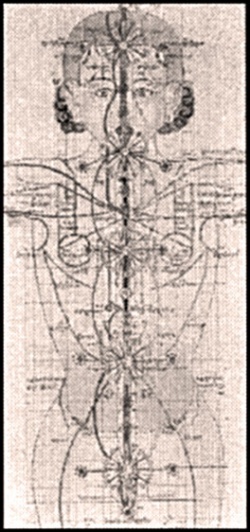Trul khor
Tsa lung Trul khor (lit. "magical movement instrument, channels and inner breath currents") known for brevity as Trul khor (lit. "magical instrument" or "magic circle;" Sanskrit: adhisāra) is a Himalayan tantric discipline which includes breathwork (or pranayama), meditative contemplation (or dhyana) and precise dynamic movements (or Body work) to centre the practitioner and to engender the body-mind precision of a keened instrument. "Lung" or "Tsa lung" is the Tibetan term for Qi and Prana (spiritual energy).
Chögyal Namkhai Norbu Rinpoche, a prominent exponent of Trul khor, prefers to use the Sanskrit equivalent term, Yantra Yoga, when writing in English. Trul khor hones the practitioner's faculty and supports the mindstream re-emergence of natural body-mind or primordial awareness or rigpa (cf. Dzogchen).
Trul khor traditionally consists of 108 movements, including bodily movements (or dynamic asana), incantations (or mantra), breathwork, and visualizations, all timed to heart rhythms. The flow or vinyasa (Sanskrit) of movements are enlikened to beads on a mala. The body postures (or asanas) of ancient Himalayan yogis are depicted on the walls of the Dalai Lama's summer temple of Lukhang.
Himalayan physical yogas vary between lineages and the complexity of the practices are not disclosed until a deep level of samaya is realised by the practitioner
Tsa lung
The 'subtle body' which is often referred to as the Vajra Body in medieval Tibetan Buddhist discourse is constituted by the flow of subtle energy currents: 'rtsa' (Wylie) is equivalent to Sanskrit: nāḍī, sirā, srota and dhamanī; 'rlung' (Wylie) is equivalent to Sanskrit: prāna or vāyu. Metaphorically, the two outer channels are gendered in the Himalayan tradition of Buddhism and Bon where the male channel is lunar and Moon oriented and the female channel is solar and Sun oriented which is a particular inversion of Shavite, Shakta and Shakti tantric traditions of Sanatana Dharma where the male is generally identified as solar and the female as lunar.
English discourse
Namkhai Norbu et al. (2000, revised) opened the discourse of a Buddhist and Bonpo Dzogchen synthesis of Trul Khor into English with his treatise on Yantra Yoga, essentially a commentary on a practical yoga manual by Vairotsana, 'phrul 'khor nyi zla kha sbyor gyi dgongs 'grel dri med nor bu'i me long (Wylie). Namkhai Norbu holds that Vairotsana codified this work from oral instruction by Padmasambhava. That said, Sri Singha a student and teacher of Padmasambhava and also a teacher of Vairotsana spent considerable time in what is now known as China. Indeed, Vairotsana also spent time in what is now known as China. Trul Khor has a clearly marked similarity to certain Taoist movement systems as well as esoteric Indian yoga traditions of tantra and Chinese traditions of Tantra which coalesced at Mount Wutai amongst other locations. The East Mountain Teachings which unified with the tradition of Dzogchen—refer Barber (1990) -- also contained esoteric systems of movement. The East Mountain Teachings were present in Mount Wutai. Sri Singha spent a number of years at Mount Wutai. Interestingly, the Five Pure Lights as an iconographic aureole of the Dzogchen practitioner and metonymic of the Rainbow Body is a motif found in poetry of Mount Wutai refer Cartelli (2004) where:
- "...a cloud no longer appears as the floating cloud so familiar in the Chinese literary tradition but as a five-colored cloud or nimbus surrounding the bodhisattva Manjusri and his various forms. The five-colored cloud is one of many numinous traces (lingji), or holy traces (shengji), of Manjusri and other extraordinary beings which appear repeatedly in the Mount Wutai poems."
Namkhai Norbu tilled the ground for the dissemination of Yantra Yoga through his practical teaching and esoteric transmission of this discipline within the International Dzogchen Community which he founded post 1975 from its seat in Italy, Merigar. Chaoul (2006) has opened the discourse of Bon traditions of Trul Khor into Western scholarship in English with his thesis from Rice University. In his work, Chaoul makes reference to a commentary by the famed Bonpo Dzogchen master, Shardza Tashi Gyaltsen, byang zab nam mkha' mdzod chen las snyan rgyud rtsa rlung 'phrul 'khor (Wylie).
Tenzin Wangyal's text Awakening the Sacred Body presents some of the basic practices of trul khor according to the Tibetan Bon tradition.
